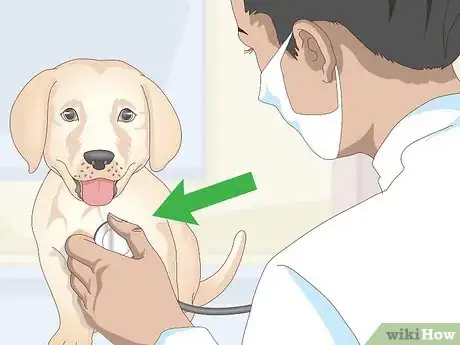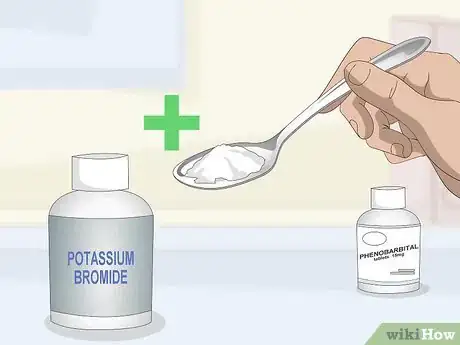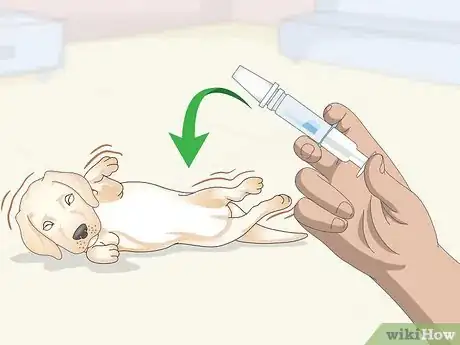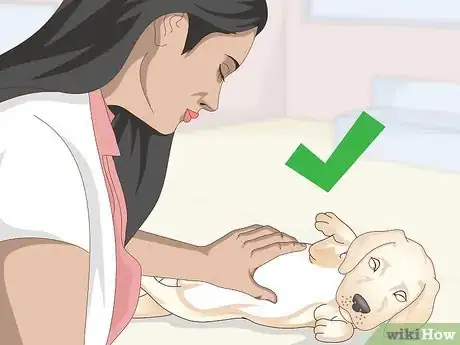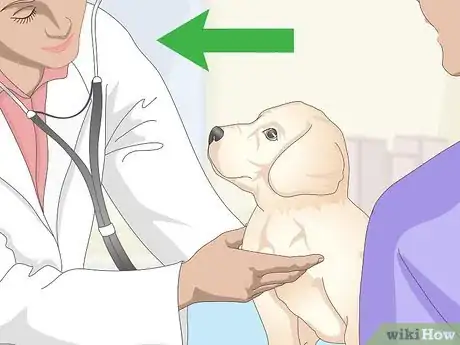This article was co-authored by Pippa Elliott, MRCVS. Dr. Elliott, BVMS, MRCVS is a veterinarian with over 30 years of experience in veterinary surgery and companion animal practice. She graduated from the University of Glasgow in 1987 with a degree in veterinary medicine and surgery. She has worked at the same animal clinic in her hometown for over 20 years.
This article has been viewed 38,984 times.
Focal seizures occur when your dog experiences a surge of electrical activity in one part of the brain. They are different than generalized seizures because focal seizures only affect part of the brain, and therefore, part of the body. However, that doesn’t mean they don’t seem scary! Don’t worry, most seizures can be successfully treated. Work with your vet to figure out a treatment plan that might include medications, natural remedies, or a combination of both. Finally, you can learn how to care for your dog during and after seizures to help keep them safe and healthy.
Steps
Using Medical Care to Treat Seizures
-
1Allow your vet to perform an exam and run tests on your dog. Take your dog to the vet so that you can try to figure out the underlying causes of the seizures. In order to make the best diagnosis and treatment plan, your vet will perform a basic physical exam. [1]
- Additionally, your vet might want to get some lab work to assess your dog’s kidney and liver functions. Common tests include blood and urine analysis. These might help determine what type of medication your vet prescribes.
- Talk to your vet about the need for medication. Although severe seizures may require medication, focal seizures that are mild and have a minimal physical impact on your dog may not require ongoing medication.
- Focal seizures are treated the same as any other type of seizure.
-
2Discuss using Phenobarbital. Talk to your vet about this common anti-seizure medication, which is considered very effective. If your vet prescribes Phenobarbital, ask about the correct dosage for your dog.[2]
- Typically, you’ll give this medication to your dog every 12 hours in the form of a pill.
- Ask your vet about potential side effects, such as a lack of energy in your dog, or trouble with balance.
- Talk to your vet about possible long-term effects, such as liver damage.
Advertisement -
3Use potassium bromide in addition to Phenobarbital. It can take a while for this medication to have its desired effect, so it is mostly used as a supplement to others. If your dog isn’t benefiting from Phenobarbital alone, ask your vet about adding potassium bromide. It might prove effective after several weeks.[3]
- Follow the dosage instructions from your vet. If your dog doesn’t do well taking pills, ask your vet for suggestions
- Discuss any possible side-effects, such as weight gain, excessive urination, and restlessness. There is potential for liver damage with long-term use, but that is very rare.[4]
-
4Try rectal diazepam for cluster seizures. Sometimes focal seizures can occur in “clusters,” which means your dog has 2 or more in a 24-hour period. Injecting diazepam into your dog’s rectum can stop the frequency and severity of the seizures. Ask the vet to show you how to inject the medication. Take a video on your phone so that you can view the demonstration later if you need to.[5]
- You can administer this medication up to 3 times in 24 hours. If your dog is still seizing after 3 doses, take them to the emergency vet.
Trying Natural Remedies
-
1Consider acupuncture to prevent seizures. While natural remedies aren’t backed by scientific research, many people claim that their dogs have experienced relief by using certain methods. Acupuncture is the process of inserting thin, long needles into certain pressure points, which might relieve pain and stop the frequency of seizures. Talk to your vet before trying acupuncture for your dog.[6]
- Keep in mind that acupuncture is usually used in addition to medication, not in place of it.
- Ask your vet, family, and friends for recommendations for professional acupuncturists. You might also want to check out online reviews.
- Only allow a professional with experience treating dogs to work on your pet.
-
2Talk to your vet about Chinese herbal formulas. Some people believe that Chinese herbal medication can help reduce seizures in dogs. Ask your vet if herbal remedies might help your pet.[7]
- Remember that herbal formulas may not be proven effective. Don't delay treating your dog with medication.
- Gastrointestinal upset, such as diarrhea, is a common side-effect.
- It may seem as though your dog gets worse before better. That is common.
- Herbs might be used to prolong the effects of acupuncture sessions.
-
3Discuss changing your dog’s diet. Since your dog’s food has a big impact on their overall health, it makes sense that changing their diet might help control the seizures. Some vets recommend a high-fat, low-carb diet, or a low salt diet, which may reduce seizures. Talk to your vet before changing your dog’s food.[8]
- Ask your vet for a dog food that is right for your pet. You can also ask about making your own dog food, if you want to try that.
- Ask your vet about giving your dog fish oil supplements, which might help prevent seizures. It's usually safe to give your dog "people" fish oil, but there are also special pills for dogs. Ask your vet which is right for your dog, and follow the vet's dosage instructions, rather than those on the bottle.[9]
Providing Continuous Care
-
1Notice warning signs of a seizure. Although it will probably always feel scary when your dog has a focal seizure, you’ll likely handle it better once you recognize some signs. Before a seizure, dogs typically exhibit behavioral changes, such as seeming anxious or unfocused. During focal seizures, your dog might also snap its mouth and appear to be biting at flies.[10]
- If you think a seizure is coming, move sharp objects, other dogs, and children away from your dog. This reduces the likelihood of the dog accidentally getting hurt.
- You can allow your dog to eat and drink small amounts, but don't let them have an excessive amount of anything.
-
2Remain calm during and after seizures. While its normal to feel anxious during a seizure, try to stay calm for your dog. Speak to them in a steady, gentle voice. Give your dog space, but stay nearby. You’ll be a soothing presence for them.
-
3Help relax your dog after a seizure with soothing substances. Your dog might feel pretty shaky after a seizure, and that's normal. You can give them a small amount of rescue remedy to help calm them. Add a small dish of vanilla ice cream to help level out the blood sugar.
- Make sure to monitor your dog for additional warning signs of a seizure. They can sometimes come again rapidly.
- You can also make your dog more comfortable by helping them to cool down. Consider a cool, damp cloth or placing a gentle fan in front of them.
-
4Take your dog for regular checkups. If your dog is prone to seizures, it’s even more important than usual to provide consistent medical care. Your vet might also want to regularly do lab work on your dog to make sure any medications are working properly. Ask your vet how frequently you should bring your dog in.
Warnings
- Both phenobarbital and potassium bromide can cause your dog to have decreased coordination and other symptoms.⧼thumbs_response⧽
References
- ↑ https://vet.osu.edu/vmc/companion/our-services/neurology-and-neurosurgery/more-epilepsy
- ↑ https://www.petmd.com/pet-medication/phenobarbital
- ↑ https://vet.osu.edu/vmc/companion/our-services/neurology-and-neurosurgery/more-epilepsy
- ↑ https://canna-pet.com/side-effects-phenobarbital-dogs/
- ↑ https://vet.osu.edu/vmc/companion/our-services/neurology-and-neurosurgery/more-epilepsy
- ↑ https://www.petmd.com/dog/wellness/natural-remedies-epilepsy-and-seizures-dogs
- ↑ https://www.petmd.com/dog/wellness/natural-remedies-epilepsy-and-seizures-dogs
- ↑ https://www.petmd.com/dog/wellness/natural-remedies-epilepsy-and-seizures-dogs
- ↑ https://www.akc.org/expert-advice/nutrition/vitamins-supplements/fish-oil-for-dogs/
About This Article
To treat focal seizures in your dog, look out for warning signs of a seizure, such as your dog appearing unfocused or snapping its mouth repeatedly. Then, move all sharp objects out of the way and soothe your dog by tallking to it in a calm voice. Following the seizure, give your dog a small bowl of vanilla ice cream to boost its blood sugar. Afterwards, take it to your vet, who may prescribe anti-seizure medications such as Phenobarbital and potassium bromide. To learn about other types of treatments for your dog, including acupuncture, keep reading!
